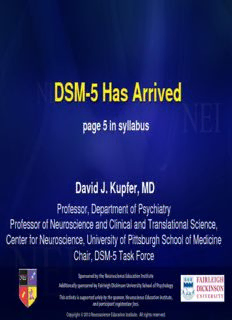
DSM-5 Has Arrived PDF
Preview DSM-5 Has Arrived
DSM-5 Has Arrived page 5 in syllabus David J. Kupfer, MD Professor, Department of Psychiatry Professor of Neuroscience and Clinical and Translational Science, Center for Neuroscience, University of Pittsburgh School of Medicine Chair, DSM-5 Task Force Sponsored by the Neuroscience Education Institute Additionally sponsored by Fairleigh Dickinson University School of Psychology This activity is supported solely by the sponsor, Neuroscience Education Institute, and participant registration fees. Copyright © 2013 Neuroscience Education Institute. All rights reserved. Individual Disclo sure Statement Faculty Author / Presenter David J. Kupfer, MD, is a professor in the department of psychiatry and a professor of neuroscience and clinical and translational science in the center for neuroscience at the University of Pittsburgh School of Medicine, PA. Consultant/Advisor: Servier (spouse) Dr. Kupfer reports receiving consulting fees from the American Psychiatric Association for serving as the Chair of the DSM-5 Task Force. Copyright © 2013 Neuroscience Education Institute. All rights reserved. Learning O bjectives • Describe the major changes made to the DSM between DSM-IV and DSM-5, including manual- wide changes and diagnosis-specific changes • Explain the rationale for the changes to the chapter structure in DSM-5 • Explain how changes made in DSM-5 might affect clinical practice • Explain how changes made in DSM-5 might affect research outcomes Copyright © 2013 Neuroscience Education Institute. All rights reserved. Pretest Qu estion 1 In DSM-5: 1. The DSM-IV multiaxial system was fully retained 2. The DSM-IV multiaxial system was modified 3. The DSM-IV multiaxial system was replaced with a new multiaxial system 4. The multiaxial system was removed Pretest Qu estion 2 The chapter organization of DSM-5 1. Retains that of DSM-IV 2. Replaces that of DSM-IV with an alphabetical one 3. Replaces that of DSM-IV with a developmentally- informed one 4. Was entirely determined by the World Health Organization DSM-5 – The Future Arrived David J. Kupfer, MD Emily A. Kuhl, PhD Darrel A. Regier, MD, MPH JAMA 2013;309:1691-1692. Strategies for Im proving DSM • Incorporate research into the revision and evolution of the classification • Move beyond a process of clinical consensus and build diagnoses on a foundation of empirical findings from scientific disciplines • Seek multidisciplinary, international, scientific participation in the task of planning the DSM-5 revision APA/WHO/NIH Diagnosis Research Planning Conferences: Participant Distribution Eastern Mediterranean, 5 Africa Europe (Cont) Kenya, 2 Greece, 1 Nigeria, 3 Hungary, 1 South Africa, 4 Italy, 5 Luxembourg, 1 Latin America Netherlands, 12 Europe, 119 Argentina, 2 Norway, 2 Brazil, 4 Russia, 4 U.S.A., 194 Chile, 3 Spain, 5 Mexico, 5 Sweden, 4 Puerto Rico, 2 Switzerland, 21 South Asia, 10 UK, 41 Eastern Mediterranean South Asia Bahrain, 1 India, 5 Israel, 3 Pakistan, 2 Western Pacific, 32 Lebanon, 1 Sri Lanka, 1 Thailand, 2 Europe Belarus, 1 Western Pacific Latin America, 16 Africa, 9 Belgium, 2 Australia, 9 Denmark, 4 China, 9 Canada, 12 Estonia, 1 Japan, 8 France, 3 Korea, 3 Germany, 11 New Zealand, 3 - 397 Participants - 39 Countries - 16 Developing Nations - 51% Non-US Participants - 10% Developing Nation Paticipants DSM-5 Conference Output • 13 conferences (2003-2008) • 10 monographs published Dimensional Models of Personality Disorders Diagnostic Issues in Substance Use Disorders Diagnostic Issues in Dementia Dimensional Approaches in Diagnostic Classification Stress-Induced and Fear Circuitry Disorders Somatic Presentations of Mental Disorders Deconstructing Psychosis Depression and GAD Obsessive-Compulsive Behavior Spectrum Disorders Public Health Aspects of Psychiatric Diagnosis • More than 200 journal articles published
Description: